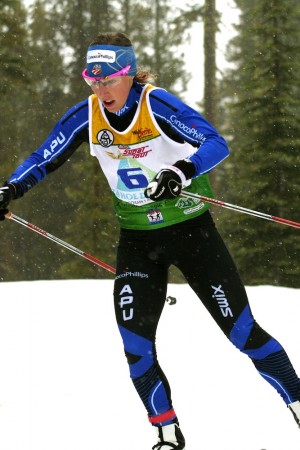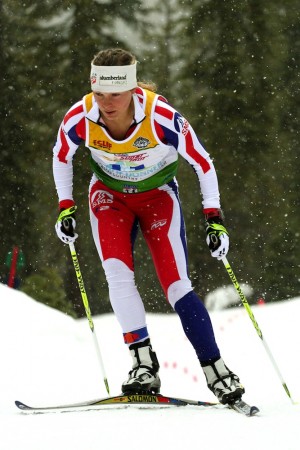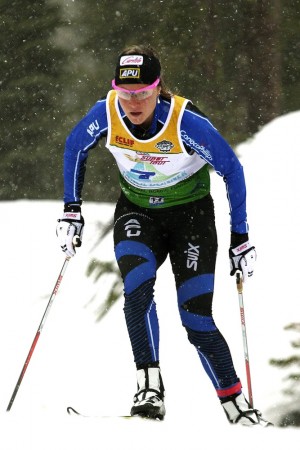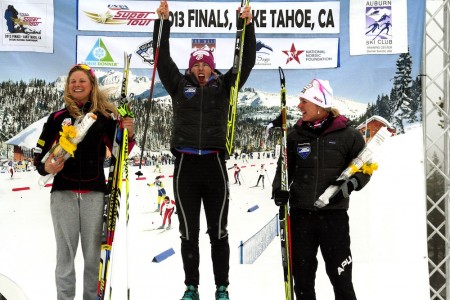
FasterSkier’s coverage of SuperTour Finals and U.S. Distance Nationals is brought to you by the generous support of Concept2, the leading manufacturer of indoor rowers, racing oars, and the SkiErg.
SODA SPRINGS, Calif. — When competitors signed up for this year’s edition of SuperTour Finals, they knew they were getting themselves into a certain kind hurt. The race courses all sit at around 7,000 feet above sea level and are essentially guaranteed to make the lungs burn and the legs ache. Misjudge the time to the finish line or go too hard in an early kilometer once on course, and good luck getting back to the stadium.
Your technique will disintegrate, for example. You will question your own ability to move forward up hills.
For the top athletes in the sport, extreme pain is par for the course — the trick to moving past it is to control it. When athletes woke up on Thursday morning to overcast skies and miserable rain, the weather was just another factor to to work around during the 3.3 k freestyle prologue. There is always the potential for conditions to affect the outcome of a race by changing midway through a start list, but part of ski racing is dealing with what you can control and ignoring what you can’t.
As starters tripped the gate on Thursday at the Auburn Ski Club and made their way into the driving rain-turned-snow, it was to do what they’d done many times before: test themselves against the elements, against their competitors and against the terrain. After just over half an hour all 60 women had conquered the 3.3 k loop and its undulating hills, really steep central climb and many sharp turns.
Not surprisingly, the two-time World Cup sprint champion in their midst emerged with the fastest time after everyone came back out of the woods and clocked in at the finish.
Kikkan Randall (Alaska Pacific University/U.S. Ski Team) may make winning look easy, but the prologue was a challenge even for her. The first thing an athlete says about her race is telling, and the first words out of Randall’s mouth on Thursday morning were, “That was hard.”
“It’s such a different feeling than the prologue in Falun, [Sweden], when you’re at sea level and you have to ski a really high tempo to be breathing hard,” she explained. “Here it’s like, all of a sudden you feel kind of paralyzed. Your legs just get flooded and you’re like, ‘Ah, I can’t move!’”

Randall finished in 7:57.9 to beat her closest competitor, Jessie Diggins (SMS T2/USST), by 8.0 seconds. The U.S. Ski Team swept the top four spots; Sadie Bjornsen (APU/USST) was third, 15.6 seconds back, and Liz Stephen (Burke Mountain Academy/USST) finished fourth, 22.8 seconds out. U.S. biathlete Susan Dunklee (Craftsbury Green Racing Project) claimed the last spot in the top five, two seconds behind Stephen.
In fact, Randall’s time ended up being the second-fastest time of the day, men’s or women’s. The continued snowfall slowed the course down for the men, and race-winner Erik Bjornsen (APU/USST) was the only one to squeak ahead of her mark; his time was ten seconds ahead of Randall’s.
“This should be a good way to get things started,” Randall said. “Hopefully the pain of today will fade for this evening and I’ll be excited to go again tomorrow.”
As the best sprinter in the world two years running and the third-ranked all-around skier in the world in 2013, Randall sets the standard by which her competitors gauge their performances. As Diggins put it, “Any time I’m within seven seconds of Kikkan in a race this long, it’s like, ‘All right!’”
Another central measure of feedback was how well athletes felt they paced the 3.3 k around the focal point of the course: an intimidating A-climb midway through. Add in the altitude factor and it was a real lung-burner; skiers couldn’t spend all their energy getting up the hill or they would risk exploding spectacularly in the remaining kilometer.
“The strategy for me was to try and pace it really carefully and not absolutely blow up,” Diggins said. “There’s a whole lot of false flat after the big up and down. I think I went out a little cautiously, and I think if I would do it again I’d maybe push it more from the start. But overall I’m extremely satisfied with it.”
The slant of the climb was confounding, even for World Cup skiers. The high side of the trail is to the right, and Bjornsen, for one, struggled to V1 up it on her weak side.

“At the top of the climb I was like, ‘Well, this is starting to get embarrassing,’” she said. “I was just barely moving over the top… I V1-ed to my right for the first time — I’ve never done that in a race, so I’m pretty proud of myself because the hill was tilted awkwardly. That’s probably why it felt so slow.”
Stephen, whose bread and butter are usually impossibly steep climbs, conceded she might have pushed herself too much on the big climb.
“Yeah, I blew up on the hill, so I think I probably went out a little hard,” she said.
All four women are at the tail end of a long season filled with hundreds if not thousands of miles of travel, so while they’re at SuperTour Finals to race well, they’re also not too concerned with results.
“My expectations for the week are to take it back a notch and enjoy ski racing for the reason I got into it: because I love it,” Stephen said. “The stressful part of the season is over and I’m just enjoying the ride now.”
Her teammates echoed the sentiment. A few of them took breaks from training in between World Cup Finals and SuperTour Finals in order to find a way to re-motivate for the last five races of the year.
“To be honest, right after World Cup Finals I thought I was pretty much done,” Diggins said. “Physically and mentally I was just really burnt out on racing. But I came out here and Kikkan and I went alpine skiing for a few days, I took the week off to have a little mini-vacation. And that really helped; I was pretty surprised and really psyched yesterday to be excited about racing tomorrow. I think no matter how done I think I am, I still want the endorphin rush.”
SuperTour Finals continues on Friday with a 10 k classic mass start at Auburn Ski Club. Randall sits atop the Finals standings with her win and the accompanying 15-second time bonus for the stage win.
— Alex Matthews contributed reporting.
Photos courtesy of Mark Nadell at MacBeth Graphics. Click here for his SuperTour Finals gallery.

Audrey Mangan
Audrey Mangan (@audreymangan) is an Associate Editor at FasterSkier and lives in Colorado. She learned to love skiing at home in Western New York.



